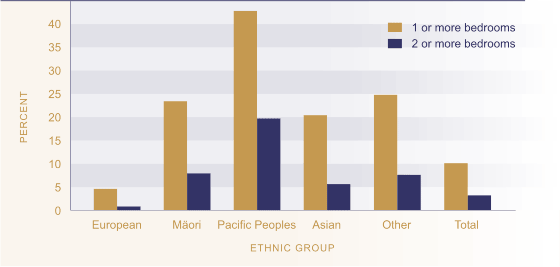Relevance
Housing space adequate to the needs and desires of a family is a core component of quality of life. The Canadian Crowding Index is a proxy measure to monitor incidence of 'crowding' in the population.
National and international studies indicate an association between the prevalence of certain infectious diseases and crowding55 as well as between crowding and poor educational attainment. Crowding can also contribute to psychological stress for people in the households concerned.
Current Level And Trends
In 2001, 108,900 people, or 3.2 percent of the New Zealand resident population, lived in households requiring two or more additional bedrooms. A further 239,500 people (6.9 percent) required just one further bedroom. In total, 348,400 people (10.1 percent) lived in households requiring at least one more bedroom to accommodate household members adequately, based on the criteria in the Canadian Crowding Index (see Appendix Two).
In the five years to 2001, the number of people living in households requiring two or more bedrooms declined by around 6,000; there were 115,300 people (3.4 percent) in that situation in 1996.
Figure EC6.1 Proportion of population
living in households requiring additional bedrooms, by ethnic group,
2001

Source: Statistics New
Zealand (1998c)
Age And Sex Differences
Household crowding is more likely to be experienced by younger people than older people. In 2001, 17 percent of children under the age of 10 years lived in households requiring at least one more bedroom, compared to 15 percent of 10-14 year-olds. Among all adults aged 15 and over, 8 percent lived in crowded households but this ranged from 16 percent of 15-24 year-olds, to 9 percent of 25-44 year-olds, 5 percent of 45-64 year-olds, and just 2 percent of those aged 65 and over.
In 1996, just over 50,000 children under 18 years (5.3 percent of all children under 18) were living in households which required two or more additional bedrooms.56 In 2001, 42,900 dependent children (under 18 and not employed full-time) were in this situation, accounting for 4.8 percent of all dependent children.
There is almost no sex difference in the likelihood of living in crowded households, except at ages 25-44, where females are slightly more likely than males to live in households requiring at least one extra bedroom (10 percent, compared to 9 percent).
Ethnic Differences
Pacific people are far more likely to be living in crowded households than other ethnic groups. In 2001, a total of 43 percent of Pacific people lived in households requiring extra bedrooms (20 percent requiring two or more, 23 percent just one more). Other ethnic groups were the next most likely, with 25 percent requiring at least one extra bedroom, followed by Māori (23 percent) and Asians (20 percent). Partly reflecting their older age profile, only 5 percent of European New Zealanders were living in houses that met the definition of crowding used here.
The largest group of those living in households requiring at least one extra bedroom were those who identified as European (38 percent), followed by Māori (34 percent), Pacific people (28 percent), Asian (14 percent) and Other ethnic groups (just 2 percent).57 However, of those living in more severe crowding situations (households requiring two or more bedrooms), Pacific people and Māori made up the largest groups (41 percent and 38 percent, respectively).
Cultural attitudes and economic conditions are two primary factors which account for the extreme variation in crowding levels between ethnic groups. The variance in population age structures is also a factor: both Māori and Pacific peoples ethnic groups have younger age structures than the European population.
Regional Differences
There is considerable regional variation in household crowding. Whether measured by population or household, Manukau City has by far the worst level of household crowding (24 percent of people, 13 percent of households required one or more bedrooms in 2001). The next worst levels were in Opotiki District and Porirua City, where almost one in five people, and one in 10 households required at least one more bedroom. Other local authority areas with relatively high levels of crowding were Auckland City and the Far North, Wairoa and Kawerau Districts. All of the South Island local authorities had lower than average levels of household crowding.
Socio-Economic Differences
Unemployed people are more likely to be living in crowded households than those with full-time jobs (20 percent and 6 percent, respectively). Other groups with crowding levels above the average adult level of 8 percent include those with no qualifications (10 percent) and those who receive income support (16 percent).58
There is a clear correlation between levels of income and levels of crowding: in 2001, 6 percent of households in the bottom quartile of equivalised household income required one or more bedrooms, compared with 2 percent of those in the top income quartile.
Households in rental accommodation were more likely to be crowded (11 percent) than those in dwellings owned with a mortgage (4 percent) or mortgage-free (2 percent).
